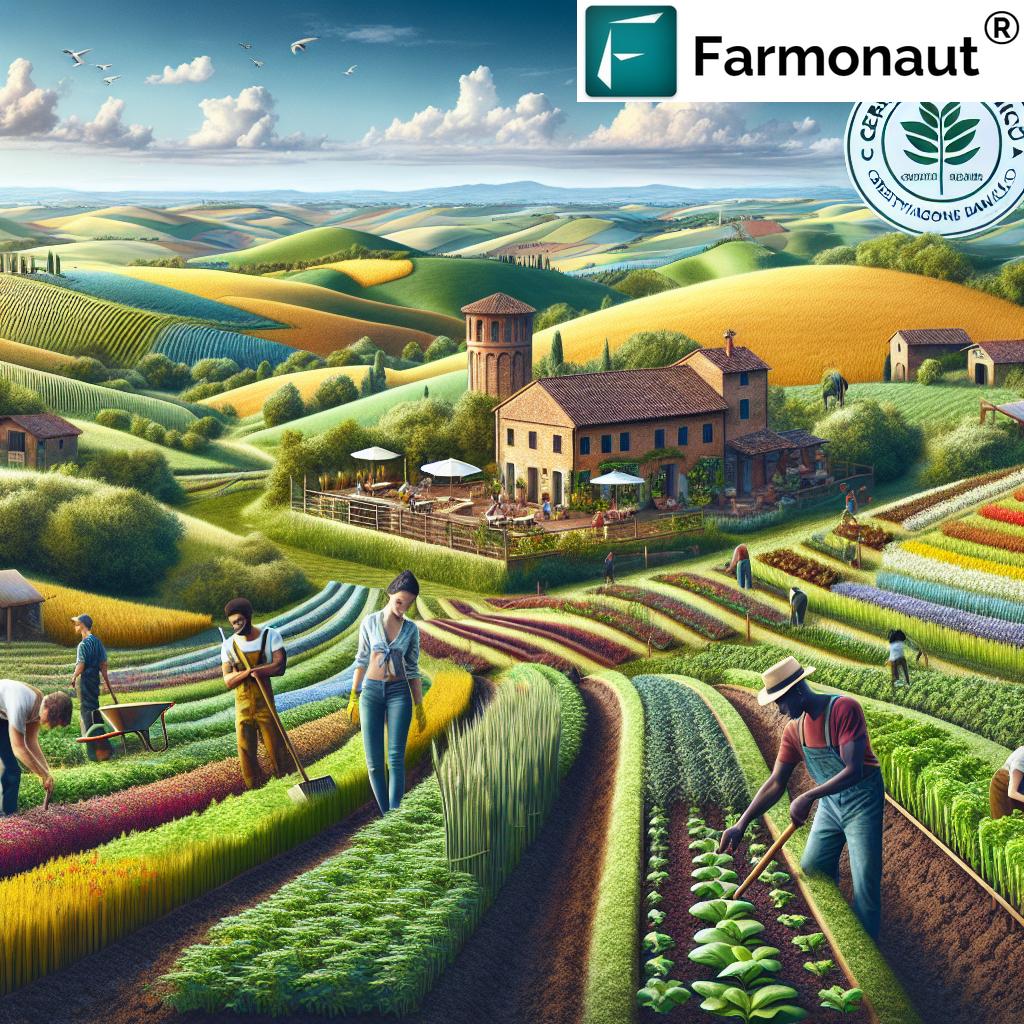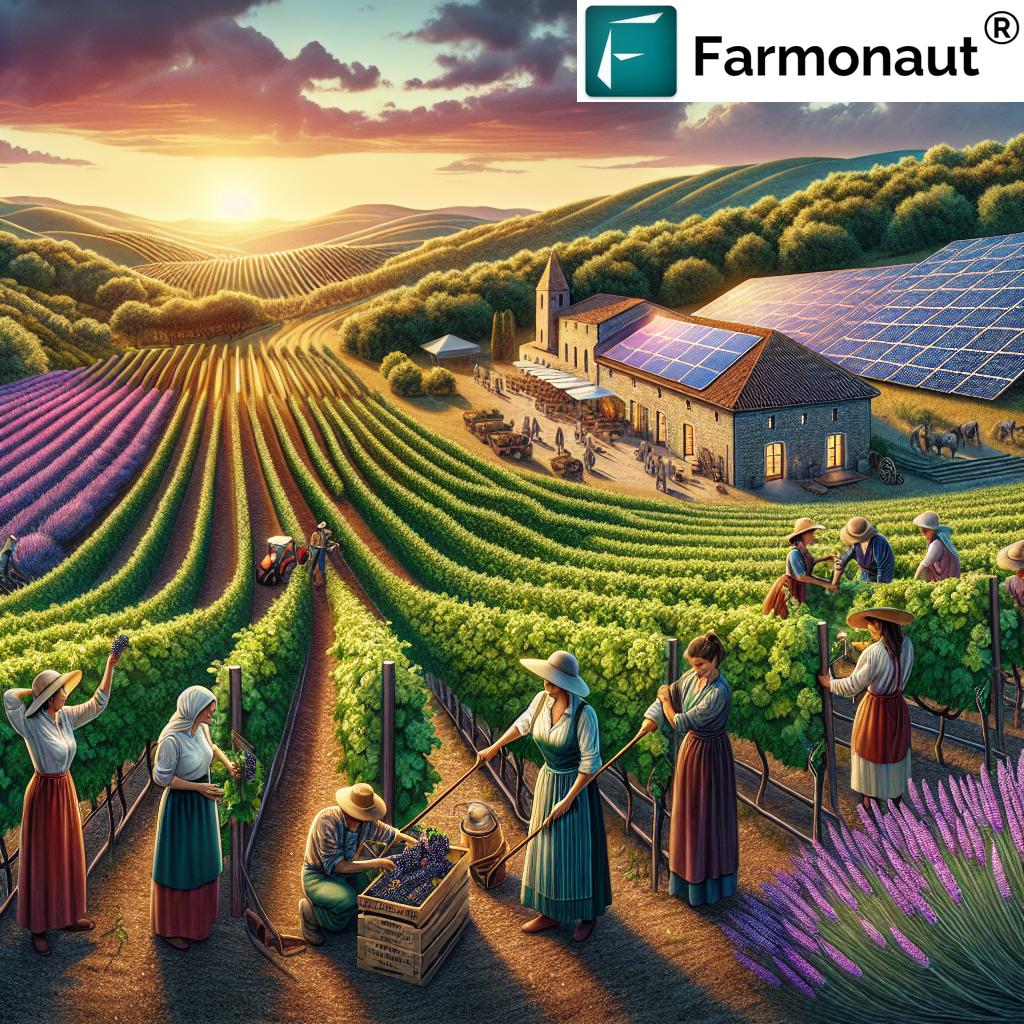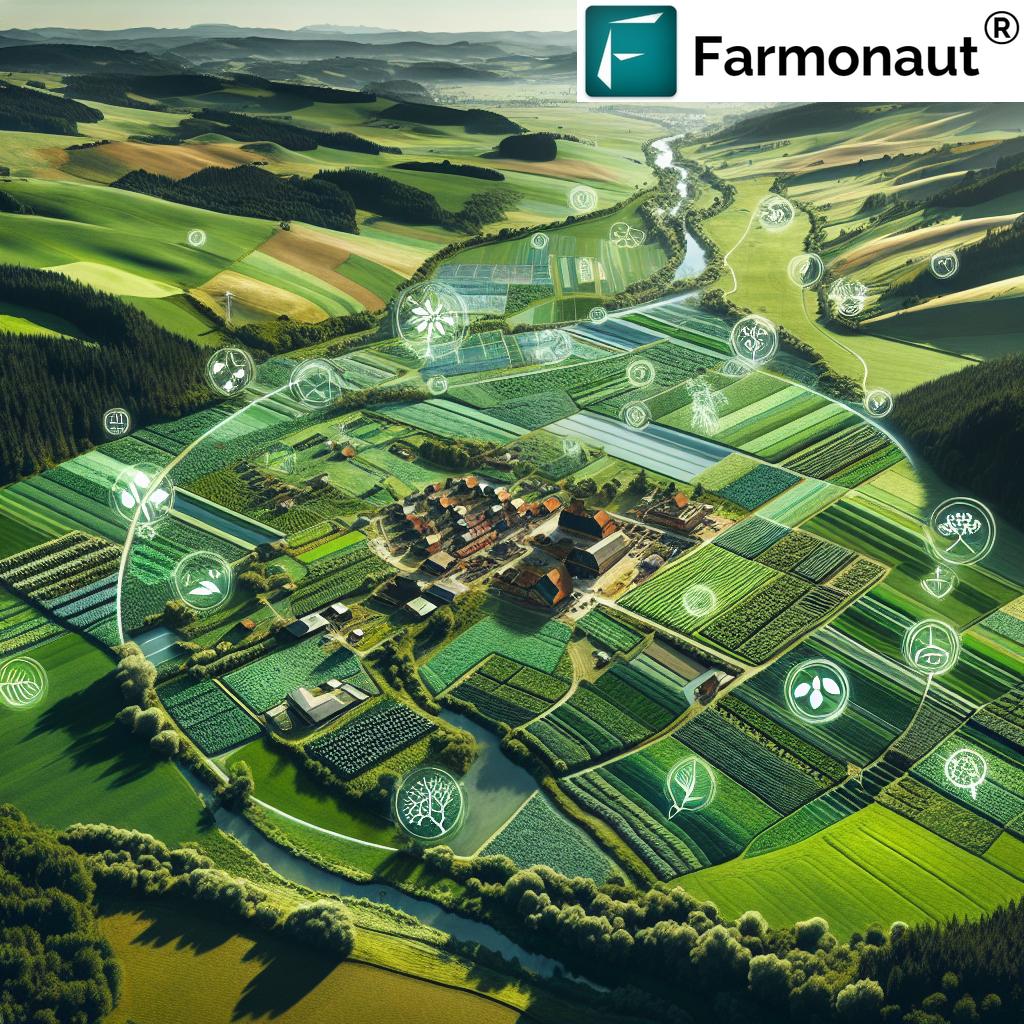Germany Agriculture Industry 2025: Innovations & Outlook
“By 2025, over 60% of German farms are expected to adopt precision farming technologies for increased efficiency.”
Table of Contents
- Introduction
- Overview of Germany’s Agriculture Industry
- Technological Integration and Precision Farming
- Comparison Table: Key Agricultural Innovations in Germany (2025)
- Digitalization & Data: The Future of Agriculture in Germany
- Sustainability and Environmental Initiatives
- Economic and Market Dynamics in Germany Farming
- Climate Change and Labor Shortages
- Farmonaut Satellite Solutions for German Agriculture
- Outlook: Future Trends for Germany Agriculture Industry 2025 & Beyond
- FAQ: Germany Agriculture Industry 2025
Introduction
The Germany agriculture industry plays a vital role in ensuring food security, supporting rural employment, and contributing to the country’s sustainable development goals. As we enter 2025, the agriculture of Germany is experiencing a dynamic transformation, blending traditional farming practices with technological and environmental innovations designed to meet both present challenges and future demands.
This article explores the current state of farming in Germany, the pivotal innovations shaping the sector, and the strategic outlook for 2025 and beyond. Emphasizing digital integration, sustainability, and precision practices, we analyze how the industry is responding to global trends and setting a benchmark for agricultural advancement in Europe.
Overview of Germany’s Agriculture Industry
Germany stands as one of Europe’s leading agricultural producers, with its agriculture industry characterized by a diverse system that includes crop cultivation, livestock farming, and forestry. The agriculture Germany sector covers roughly 47% of the country’s total land area, reflecting its central role in the national economy.
- Major crops include cereals (wheat, barley, rye), rapeseed, potatoes, and sugar beets.
- Livestock production is headed by pork, poultry, and dairy.
- The sector produces approximately 1.3% of Germany’s GDP and employs around 1.5 million people.
- Germany’s agriculture industry also supports rural transformation by modernizing farming techniques and infrastructure.
The blend of traditional and innovative practices ensures that Germany farming remains resilient against external shocks, sustaining both large-scale commercial operations and small family farms. With increasing focus on technological integration, the agriculture Germany sector is redefining European standards for efficiency, productivity, and environmental responsibility.
Technological Integration and Precision Farming: Revolutionizing Farming in Germany by 2025
The advent of precision agriculture has established itself as the cornerstone of the Germany agriculture industry. By 2025, the use of advanced digital technologies is widespread, with German farmers deploying a suite of tools that bring real-time data into every stage of agricultural production.
Key Components of Technological Innovation in Germany Agriculture Industry
- GPS-Guided Machinery: Tractors and equipment utilize GPS navigation systems for precise seeding, fertilizing, and harvesting, minimizing waste, reducing fuel use, and increasing labor efficiency.
- Drones and Remote Sensing: Drones map fields, monitor crop development, and detect pest outbreaks with high accuracy, while satellites—such as those leveraged through Farmonaut—provide critical data on vegetation health (NDVI), soil moisture, and changing crop conditions across large acreages.
- IoT-Enabled Sensors: Internet of Things (IoT) devices measure soil health, nutrient levels, weather patterns, and even plant stress, sending actionable data to smartphones and farm management systems.
- Artificial Intelligence & Big Data Analytics: Machine learning algorithms interpret complex datasets, forecast yields, optimize resource allocation, and predict weather-related risks.
The widespread adoption of digital and precision technologies allows farming in Germany to become increasingly sustainable and productive, empowering farmers to:
- Optimize the use of fertilizers, pesticides, and water, thus reducing costs and environmental impact
- Increase yields and maintain high food quality
- Ensure regulatory compliance and traceability with digital documentation and reporting
Comparison Table of Key Agricultural Innovations in Germany (2025)
A strategic focus on innovation and technology characterizes the agriculture of Germany in 2025. The comparison table below allows you to assess leading technologies shaping rural transformation and sustainability.
| Innovation / Technology | Description | Estimated Adoption Rate (% of farms) | Estimated Impact (Yield Improvement %) | Sustainability Benefit | Example Application |
|---|---|---|---|---|---|
| Precision Farming | GPS-guided machinery, targeted seeding, variable-rate application. | 60%+ | 10-20% | Reduces chemical/fuel use, lower emissions. | Autonomous tractors, smart sprayers. |
| Remote Sensing | Satellite and drone imaging for field monitoring and crop health. | 55% | 5-12% | Early detection of stress, targeted interventions. | NDVI-based health assessment, drought response. |
| Digital Farm Management | Software/app platforms integrating real-time data for operations. | 50% | 7-15% | Efficient resource use, reduced waste. | Farmonaut app, cloud dashboards. |
| Sustainable Crop Rotation | Planned alternation of crops to maintain soil fertility. | 70% | 5-10% | Preserves biodiversity, reduces pests. | Wheat/potato-rotation cycles. |
| Smart Irrigation | Water use optimized via sensors and predictive weather data. | 45% | 7-18% | Conserves water, energy efficient. | IoT soil moisture systems. |
Digitalization & Data: The Future of Agriculture in Germany
Digital transformation is rapidly reshaping the agriculture Germany industry, with data-driven tools making farming more responsive, efficient, and resilient:
- Data-driven decision support: Real-time analytics help farmers manage risks, optimize timing, and maximize resource allocation.
- Connected farms: Integration of digital farm management (see large-scale management with the Farmonaut Agro Admin App) enables seamless coordination of machinery, labor, and supply chains.
- Blockchain Traceability: Blockchain technology provides supply chain transparency, ensuring product traceability for food safety and compliance.
- Cloud-based platforms: Applications such as our Farmonaut Web App and Mobile Apps instantly deliver satellite data and analysis to stakeholders in the field.



Moreover, API access ensures developers, enterprises, and even government agencies can plug into cutting-edge satellite data for custom solutions, while our developer documentation streamlines integration.
As we move further into 2025, digital agriculture is no longer a future concept, but an actionable reality driving efficiency and sustainability across the German rural landscape.
Sustainability and Environmental Initiatives in German Agriculture 2025
Sustainability is now front and center in the agriculture Germany industry, with climate goals embedded in both policy and on-farm practices. Environmental stewardship frames national strategy, aiming for productivity that aligns with sustainable development and biodiversity protection.
“Germany’s agriculture sector aims to reduce carbon emissions by 30% through digital data and sustainable practices by 2025.”
- Organic Farming: Currently, about 12% of German agricultural land is certified organic, and this number is projected to grow. Environmental best practices such as crop rotation, reduced tillage, and integrated pest management are increasingly adopted.
- Renewable Energy on Farms: Solar panels, wind turbines, and biogas installations are mainstream. Many farms in Germany are leveraging carbon footprinting tools to track and minimize emissions.
- Biodiversity Preservation: Hedgerows, buffer strips, and conservation set-asides are supported through both national and EU-wide environmental programs.
Through strong policy alignment with the EU Farm to Fork Strategy, the German government incentivizes:
- Reduced chemical fertilizer and pesticide usage
- Resource-efficient irrigation systems
- Sustainable livestock management for lower methane emissions
The aim is to promote food security while maintaining a high standard of environmental health, soil fertility, and climate resiliency.
Economic and Market Dynamics in Germany Farming
Like many modern economies, the German agriculture industry operates under significant economic and market pressures:
-
Global Markets & Trade:
Commodity prices are volatile, driven by international supply and demand, as well as trade policies. German farmers face stiff competition but benefit from a reputation for quality. -
Shifting Consumer Demands:
There’s a growing appetite for local, organic, and sustainably produced foods, opening new market opportunities for innovative operations who invest in traceability. -
Government Support Programs:
Subsidies and rural development initiatives help small and medium-sized farms modernize, maintain viability, and adapt to changing economic realities.
Farmers also benefit from digital platforms that help connect with markets directly, share best practices, and improve logistical efficiency via smart fleet management and supply chain software.
The evolution toward higher-value, niche, and regional specialty products is a strong trend for 2025, supported by advanced digital documentation and food authenticity verification through blockchain.
Climate Change and Labor Shortages: Core Challenges Facing Agriculture of Germany
The agriculture of Germany is not immune to global threats, especially the compounding impact of climate change and labor shortages:
- Extreme Weather Events: Unpredictable weather—droughts, flooding, and persistent heatwaves—present growing risks to crop yields and livestock well-being.
- Climate Adaptation: German farmers invest in climate-resilient crops, digital soil and forest plantation advisory tools, and adaptive irrigation to ensure continued productivity in face of changing weather patterns.
- Labor Market Constraints: Urbanization, demographic shifts, and an aging rural workforce have led to shortages of skilled farm laborers.
- Mechanization & Automation: Robotics, automation, and AI have helped mitigate labor shortages in repetitive or hazardous tasks, though human expertise remains invaluable.
Strategic government programs and investments—combined with new technologies—are essential to meet these pressing challenges in 2025, ensuring the resilience and sustainability of the entire Germany agriculture industry.
Farmonaut Satellite Solutions for German Agriculture
As digital transformation accelerates, Farmonaut empowers the Germany agriculture industry with cost-effective satellite-based monitoring, AI-driven insights, and traceability tools for every scale of operation. Our platform can be accessed via web, Android, iOS, and API, delivering real-time field, crop, and energy data across Germany’s agricultural sector.
- Satellite Monitoring: Our multispectral imagery enables farmers to identify crop health issues, monitor soil moisture, and assess vegetation vigor—without leaving their desk or mobile device.
-
Jeevn AI Advisory: Delivers actionable recommendations, weather forecasts, and tailored risk mitigation strategies.
Resource: Read more about our large-scale farm management solutions. - Blockchain Traceability: Empowers German farmers and food companies to comply with the strictest food safety and export regulations.
- Environmental Impact Tracking: Our carbon footprinting and environmental modules help farms quantify emissions and biodiversity, supporting the transition to more sustainable agriculture.
Our affordable, modular subscription model ensures everyone—from smallholders to agribusinesses—has access to critical agricultural data and climate-Smart solutions. Explore our full range of services, including satellite-based crop loan and insurance verification for German farms, on our website.
For pricing, scaling, and subscription details on how Farmonaut’s platform supports the Germany agriculture industry, please refer below:
Outlook: Future Trends for Germany Agriculture Industry 2025 & Beyond
The outlook for Germany’s agriculture industry in 2025 is defined by continued evolution, marked by deeper integration of technological and sustainable practices, more resilient rural supply chains, and closer alignment to consumer and climate demands.
Key Trends and Strategic Directions
- Digitization: Nearly all rural farms will connect to IoT and remote sensing tools, making real-time field management and predictive analytics a standard.
- Sustainability: The push toward net-zero carbon will drive innovation—carbon footprinting, renewable energy, and next-generation fertilizers will be commonplace.
- Consumer Orientation: Transparency, food quality, and local production will dominate market trends, rewarding those with traceable, sustainable supply chains.
- Workforce Renewal: Improved vocational training, smart mechanization, and digital tools will address labor gaps and make farm work more attractive to new generations.
- Policy and Collaboration: Government support, research, and the diffusion of agtech will ensure a balance between productivity, ecological preservation, and economic viability.
As a result, Germany agriculture industry remains one of Europe’s most dynamic sectors—vital not only for national food security but also as a global model of innovation, resilience, and climate responsibility.
FAQ: Germany Agriculture Industry 2025
What are the main crops in Germany agriculture industry?
The primary crops are wheat, barley, rye, rapeseed, potatoes, and sugar beets. These form the backbone of the country’s arable farming, alongside specialty vegetables and fruits.
How is digital data transforming farming in Germany?
Digital data—via sensors, drones, AI, and platforms like Farmonaut—enables German farmers to monitor crop health, optimize inputs, and adapt rapidly to weather and market changes.
What challenges faces the agriculture Germany sector in 2025?
Climate change, labor shortages, market volatility, and regulatory pressures are major challenges. Innovative technologies and sustainable practices help address these risks.
What is Farmonaut and how does it benefit German farmers?
Farmonaut is a satellite technology company providing affordable monitoring, AI-driven advisory, blockchain traceability, and environmental tracking tools, helping German farms boost productivity, sustainability, and compliance.
How is sustainability addressed in the Germany agriculture industry?
Through organic farming, renewable energy investments, carbon emission tracking, biodiversity initiatives, and reduced chemical use—all supported by technology and policy frameworks.
Are there support programs for small and medium-sized farms in Germany?
Yes. The government, often aligned with the EU, supports rural transformation and market access for SMEs through targeted subsidies, modernization programs, and digitalization incentives.
How can I access Farmonaut’s tools for German farming?
Farmonaut’s solutions are available on Android and iOS apps, web browser, and API. For large and small farms, modules are scalable and can be selected based on operational needs.











